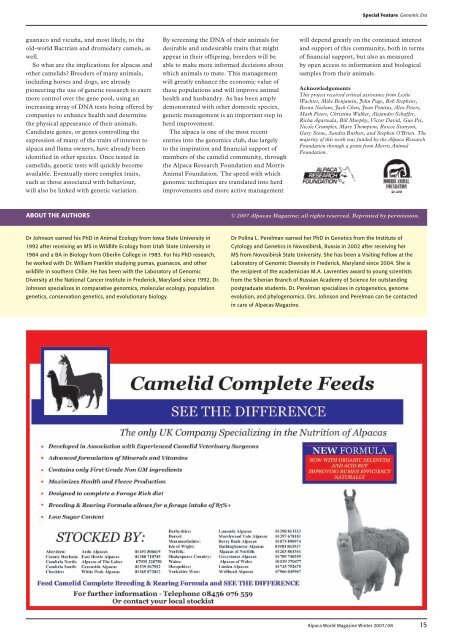Winter - Classical MileEnd Alpacas
Winter - Classical MileEnd Alpacas
Winter - Classical MileEnd Alpacas
Create successful ePaper yourself
Turn your PDF publications into a flip-book with our unique Google optimized e-Paper software.
Special Feature Genomic Era<br />
guanaco and vicuña, and most likely, to the<br />
old-world Bactrian and dromedary camels, as<br />
well.<br />
So what are the implications for alpacas and<br />
other camelids? Breeders of many animals,<br />
including horses and dogs, are already<br />
pioneering the use of genetic research to exert<br />
more control over the gene pool, using an<br />
increasing array of DNA tests being offered by<br />
companies to enhance health and determine<br />
the physical appearance of their animals.<br />
Candidate genes, or genes controlling the<br />
expression of many of the traits of interest to<br />
alpaca and llama owners, have already been<br />
identified in other species. Once tested in<br />
camelids, genetic tests will quickly become<br />
available. Eventually more complex traits,<br />
such as those associated with behaviour,<br />
will also be linked with genetic variation.<br />
By screening the DNA of their animals for<br />
desirable and undesirable traits that might<br />
appear in their offspring, breeders will be<br />
able to make more informed decisions about<br />
which animals to mate. This management<br />
will greatly enhance the economic value of<br />
these populations and will improve animal<br />
health and husbandry. As has been amply<br />
demonstrated with other domestic species,<br />
genetic management is an important step in<br />
herd improvement.<br />
The alpaca is one of the most recent<br />
entries into the genomics club, due largely<br />
to the inspiration and financial support of<br />
members of the camelid community, through<br />
the Alpaca Research Foundation and Morris<br />
Animal Foundation. The speed with which<br />
genomic techniques are translated into herd<br />
improvements and more active management<br />
will depend greatly on the continued interest<br />
and support of this community, both in terms<br />
of financial support, but also as measured<br />
by open access to information and biological<br />
samples from their animals.<br />
Acknowledgements<br />
This project received critical assistance from Leslie<br />
Wachter, Mike Benjamin, John Page, Bob Stephens,<br />
Beena Neelam, Jack Chen, Joan Pontius, Alex Peters,<br />
Mark Peters, Christina Walker, Alejandro Schaffer,<br />
Richa Agarwala, Bill Murphy, Victor David, Guo Pei,<br />
Nicole Crumpler, Mary Thompson, Roscoe Stanyon,<br />
Gary Stone, Sandra Burkett, and Stephen O'Brien. The<br />
majority of this work was funded by the Alpaca Research<br />
Foundation through a grant from Morris Animal<br />
Foundation.<br />
About the Authors<br />
© 2007 <strong>Alpacas</strong> Magazine; all rights reserved. Reprinted by permission.<br />
Dr Johnson earned his PhD in Animal Ecology from Iowa State University in<br />
1992 after receiving an MS in Wildlife Ecology from Utah State University in<br />
1984 and a BA in Biology from Oberlin College in 1983. For his PhD research,<br />
he worked with Dr. William Franklin studying pumas, guanacos, and other<br />
wildlife in southern Chile. He has been with the Laboratory of Genomic<br />
Diversity at the National Cancer Institute in Frederick, Maryland since 1992. Dr.<br />
Johnson specializes in comparative genomics, molecular ecology, population<br />
genetics, conservation genetics, and evolutionary biology.<br />
Dr Polina L. Perelman earned her PhD in Genetics from the Institute of<br />
Cytology and Genetics in Novosibirsk, Russia in 2002 after receiving her<br />
MS from Novosibirsk State University. She has been a Visiting Fellow at the<br />
Laboratory of Genomic Diversity in Frederick, Maryland since 2004. She is<br />
the recipient of the academician M.A. Lavrentiev award to young scientists<br />
from the Siberian Branch of Russian Academy of Science for outstanding<br />
postgraduate students. Dr. Perelman specializes in cytogenetics, genome<br />
evolution, and phylogenomics. Drs. Johnson and Perelman can be contacted<br />
in care of <strong>Alpacas</strong> Magazine.<br />
Alpaca World Magazine <strong>Winter</strong> 2007 / 08<br />
15







